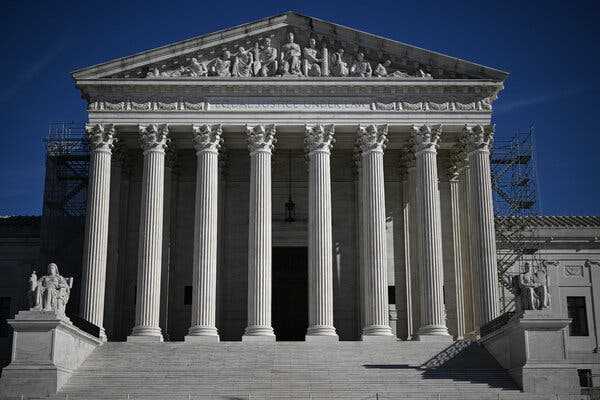The justices will hear arguments on Monday about whether members of the wealthy Sackler family can be shielded from liability through a bankruptcy settlement.
- Share full article

In agreeing to take the case, the Supreme Court temporarily halted the deal.
Purdue Pharma and the wealthy family that controlled it are forever linked to the deadly opioid epidemic, which has left hundreds of thousands of people dead.
But their role in the public health crisis is not the central question that the Supreme Court will wrestle with on Monday when it hears arguments over a bankruptcy settlement involving Purdue, the maker of the highly addictive painkiller OxyContin.
Instead, the justices will focus on a narrower issue: whether the plan, devised to address the thousands of claims brought by state and local governments, tribes, hospitals and individual victims, can give wide-ranging legal protections to members of the Sackler family, the owners of the company.
Under the deal, the Sacklers would pay up to $6 billion of their fortune toward settling those claims in exchange for immunity from all civil legal disputes related to the opioid crisis and Purdue.
A broad ruling by the court could have consequences for other major lawsuits in which a group of plaintiffs accuses an organization of similar injuries. A decision could come as late as June, near the end of the court’s term.
In recent years, bankruptcy court has become a popular place to deal with mass-injury settlements. The Purdue case and others like it rely on a system that courts in some parts of the country say allows third parties, like the Sacklers, to be freed from liability, even though they themselves are not declaring bankruptcy.
A Justice Department watchdog had asked the Supreme Court to intervene after an appeals court upheld the settlement. The agreement violated federal law, the government said, by allowing the Sacklers to take advantage of protections meant for those in “financial distress” and offered “a road map for wealthy corporations and individuals to misuse the bankruptcy system.”
Lawyers for Purdue said in court filings that the plan would “provide billions of dollars and lifesaving benefits to the victims of the opioid crisis.” The suggestion that the plan laid out a strategy for the rich seeking to avoid accountability was “unfounded,” they added.
Purdue, which is widely viewed as helping to spark the opioid crisis, has faced a flood of challenges since OxyContin’s addictive qualities and potential for abuse became clear.
The company continued to aggressively push the painkiller regardless. In 2007, a holding company for Purdue pleaded guilty to a felony charge of “misbranding” the drug, including its risk of addiction, and agreed to pay some $600 million in fines and other fees.
As the number of overdose deaths soared, municipalities, tribes, families and others sought funding to address the ravages of the drugs. Many pinned much of the blame on OxyContin.
Purdue filed for bankruptcy protection in September 2019 as civil lawsuits against the company and, increasingly, the Sacklers themselves mounted.
Under a restructuring plan, filed in March 2021, the company would dissolve and become a public benefit company focused on trying to counter the opioid epidemic. In turn, members of the Sackler family would pour billions from their personal fortune to aid states, municipalities, tribes and others in fighting the opioid crisis. More than 90 percent of the plaintiffs who voted on the plan approved it.
That September, Judge Robert Drain of the U.S. Bankruptcy Court in White Plains, N.Y., approved the plan. The U.S. Trustee Program, an office in the Justice Department, was among those that appealed the decision.
ImageProtesters displaying an image of Judge Robert Drain outside Purdue Pharma’s headquarters in 2021.Credit…Mark Lennihan/Associated Press
As an appeal wound through the courts, members of the Sackler family increased their cash offer in February 2022 to settle the thousands of opioid claims up to $6 billion. They continued to insist that they be insulated from all opioid-related lawsuits.
The United States Court of Appeals for the Second Circuit ruled in favor of the plan more than a year later, handing a victory to Purdue.
In agreeing to take the case, the Supreme Court temporarily halted the deal, most likely suspending payments to plaintiffs until it issues a ruling.
The plan authorized by the appeals court “includes one of the most significant and expansive” release of claims to a party that had not even declared bankruptcy, the solicitor general, Elizabeth B. Prelogar, wrote in asking the court to hear the case.
Lawyers for Purdue argued that if the court were to strike down the deal, “the individuals and entities with an actual stake in the outcome would lose everything.”
They pointed to the unusually high support among claimants for the plan, adding that “countless lives will be helped — and literally saved — by the billions of dollars that will flow to communities nationwide under the plan.”
Abbie VanSickle covers the United States Supreme Court for The Times. She is a lawyer and has an extensive background in investigative reporting. More about Abbie VanSickle
- Share full article
SKIP ADVERTISEMENT
Source: nytimes.com



